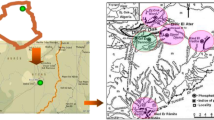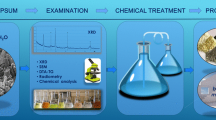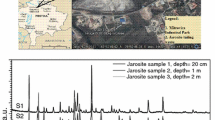Abstract
Phosphate washing waste (PWW) is one of the wastes generated by the phosphate mine with a very high amount. This waste was investigated in this work to study the effect of the calcination of the PWW at four different temperatures 600 °C, 700 °C, 800 °C and 900 °C on its mineralogical and chemical composition. The samples were investigated by X-ray powder diffraction, Fourier transform infrared, differential scanning calorimetry and thermogravimetric analysis, solid-state magic angle spinning nuclear magnetic resonance of 29Si, 27Al and 31P and scanning electron microscope. The results show that the PWW presents a complex system and it suffers a significant change on its mineralogical and chemical composition after calcination. It reveals the presence of carbonate, natural zeolite, fluorapatite, quartz and clay. After calcination, the waste shows the disappearance of some of these phases and the appearance of others and some other phases remain steady.









Similar content being viewed by others
Abbreviations
- CPG:
-
Gafsa Phosphate Company
- XRD:
-
X-ray powder diffraction
- DSC–TG:
-
Differential scanning calorimetry and thermogravimetric analysis
- FTIR:
-
Fourier transform infrared
- ATR:
-
Attenuated total reflectance
- MAS-NMR:
-
Magic angle spinning nuclear magnetic resonance
- PWW:
-
Phosphate washing waste
- SEM:
-
Scanning electron microscope
References
Ober JA. Mineral commodity summaries 2018. Report. Reston, VA; 2018.
Krekeler MPS, Morton J, Lepp J, Tselepis CM, Samsonov M, Kearns LE. Mineralogical and geochemical investigation of clay-rich mine tailings from a closed phosphate mine, Bartow Florida, USA. Environ Geol. 2007;55(1):123–47. https://doi.org/10.1007/s00254-007-0971-8.
Song Q, Li J, Zeng X. Minimizing the increasing solid waste through zero waste strategy. J Clean Prod. 2015;104:199–210. https://doi.org/10.1016/j.jclepro.2014.08.027.
Yang Y, Wei Z, Chen Y-L, Li Y, Li X. Utilizing phosphate mine tailings to produce ceramisite. Constr Build Mater. 2017;155:1081–90. https://doi.org/10.1016/j.conbuildmat.2017.08.070.
Cánovas CR, Macías F, Pérez-López R, Basallote MD, Millán-Becerro R. Valorization of wastes from the fertilizer industry: current status and future trends. J Clean Prod. 2018;174:678–90. https://doi.org/10.1016/j.jclepro.2017.10.293.
Chraiti R, Raddaoui M, Hafiane A. Effluent water quality at phosphate mines in M’Dhilla, Tunisia and its potential environmental effects. Mine Water Environ. 2016;35(4):462–8. https://doi.org/10.1007/s10230-016-0400-x.
Marzougui S, Sdiri A, Rekhiss F. Heavy metals’ mobility from phosphate washing effluents discharged in the Gafsa area (southwestern Tunisia). Arab J Geosci. 2016. https://doi.org/10.1007/s12517-016-2613-5.
Boughzala K, Fattah N, Bouzouita K, Ben Hassine H. Etude minéralogique et chimique du phosphate naturel d’Oum El Khecheb (Gafsa, Tunisie). Revue science des matériaux, Laboratoire LARHYSS. 2015;6:11–29.
Gallala W, Saïdi M, el Hajii S, Zayani K, Gaied ME, Montacer M. Characterization and valorization of Tozeur-Nefta phosphate ore deposit (southwestern Tunisia). Procedia Eng. 2016;138:8–18.
Galfati I, Sassi AB, Zaier A, Bouchardon JL, Bilal E, Joron J-L, et al. Geochemistry and mineralogy of Paleocene-Eocene Oum El Khecheb phosphorites (Gafsa-Metlaoui Basin) Tunisia. Geochem J. 2010;44(3):189–210.
Elgharbi S, Horchani-Naifer K, Ferid M. Investigation of the structural and mineralogical changes of Tunisian phosphorite during calcinations. J Therm Anal Calorim. 2015;119(1):265–71.
Galai H, Sliman F. Mineral characterization of the Oum El Khacheb phosphorites (Gafsa-Metlaoui basin; S Tunisia). Arab J Chem. 2014. https://doi.org/10.1016/j.arabjc.2014.10.007.
Mekki A, Awali A, Aloui F, Loukil S, Sayadi S. Characterization and toxicity assessment of wastewater from rock phosphate processing in Tunisia. Mine Water Environ. 2017;36(4):502–7.
Ahmed AH, Tlili A, Affouri H. ETUDE MINÉRALOGIQUE ET ORGANO-GEOCHIMIQUE DU FACIÈS PHOSPHATÉ YPRESIEN DU SUD OUEST TUNISIEN.
Jellali S, Wahab MA, Hassine RB, Hamzaoui AH, Bousselmi L. Adsorption characteristics of phosphorus from aqueous solutions onto phosphate mine wastes. Chem Eng J. 2011;169(1–3):157–65. https://doi.org/10.1016/j.cej.2011.02.076.
Jellali S, Wahab MA, Anane M, Riahi K, Bousselmi L. Phosphate mine wastes reuse for phosphorus removal from aqueous solutions under dynamic conditions. J Hazard Mater. 2010;184(1–3):226–33. https://doi.org/10.1016/j.jhazmat.2010.08.026.
Hakkou R, Benzaazoua M, Bussière B. Valorization of phosphate waste rocks and sludge from the moroccan phosphate mines: challenges and perspectives. Procedia Eng. 2016;138:110–8. https://doi.org/10.1016/j.proeng.2016.02.068.
Zhang P. Comprehensive recovery and sustainable development of phosphate resources. Procedia Eng. 2014;83:37–51. https://doi.org/10.1016/j.proeng.2014.09.010.
Baccour H, Koubaa H, Baklouti S (eds). Phosphate sludge from Tunisian phosphate mines: valorisation as ceramics products. In: Euro-mediterranean conference for environmental integration; 2017. Springer.
Loutou M, Hajjaji M, Mansori M, Favotto C, Hakkou R. Heated blends of clay and phosphate sludge: microstructure and physical properties. J Asian Ceram Soc. 2018;4(1):11–8. https://doi.org/10.1016/j.jascer.2015.10.003.
Chen Q, Zhang Q, Fourie A, Xin C. Utilization of phosphogypsum and phosphate tailings for cemented paste backfill. J Environ Manag. 2017;201:19–27. https://doi.org/10.1016/j.jenvman.2017.06.027.
Loutou M, Hajjaji M, Mansori M, Favotto C, Hakkou R. Phosphate sludge: thermal transformation and use as lightweight aggregate material. J Environ Manag. 2013;130:354–60. https://doi.org/10.1016/j.jenvman.2013.09.004.
Rashed MN, Mohamed AR, Awadallah MA. Chemically activated phosphate slime as adsorbent for heavy metals removal from polluted water. Int J Environ Waste Manag. 2015;16(2):145–65.
Khemakhem M, Khemakhem S, Ayedi S, Amar RB. Study of ceramic ultrafiltration membrane support based on phosphate industry subproduct: application for the cuttlefish conditioning effluents treatment. Ceram Int. 2011;37(8):3617–25. https://doi.org/10.1016/j.ceramint.2011.06.020.
Khemakhem M, Khemakhem S, Ayedi S, Cretin M, Ben Amar R. Development of an asymmetric ultrafiltration membrane based on phosphates industry sub-products. Ceram Int. 2015;41(9):10343–8. https://doi.org/10.1016/j.ceramint.2015.05.101.
Dabbebi R, Barroso de Aguiar JL, Camões A, Samet B, Baklouti S. Effect of the calcinations temperatures of phosphate washing waste on the structural and mechanical properties of geopolymeric mortar. Constr Build Mater. 2018;185:489–98. https://doi.org/10.1016/j.conbuildmat.2018.07.045.
Moukannaa S, Loutou M, Benzaazoua M, Vitola L, Alami J, Hakkou R. Recycling of phosphate mine tailings for the production of geopolymers. J Clean Prod. 2018;185:891–903. https://doi.org/10.1016/j.jclepro.2018.03.094.
Liu X, Zhang Y, Liu T, Cai Z, Sun K. Characterization and separation studies of a fine sedimentary phosphate ore slime. Minerals. 2017;7(6):94. https://doi.org/10.3390/min7060094.
Claverie M, Martin F, Tardy JP, Cyr M, De Parseval P, Grauby O, et al. Structural and chemical changes in kaolinite caused by flash calcination: formation of spherical particles. Appl Clay Sci. 2015;114:247–55. https://doi.org/10.1016/j.clay.2015.05.031.
Chotoli FF, Quarcioni VA, Lima SS, Ferreira JC, Ferreira GM. Clay activation and color modification in reducing calcination process: development in lab and industrial scale. Calcined Clays for Sustainable Concrete. Berlin: Springer; 2015. p. 479–86.
Ahmed AH, Tlili A, Affouri H. ETUDE MINÉRALOGIQUE ET ORGANO-GEOCHIMIQUE DU FACIÈS PHOSPHATÉ YPRESIEN DU SUD OUEST TUNISIEN; 2008.
Gelves JF, Gallego GS, Marquez MA. Mineralogical characterization of zeolites present on basaltic rocks from Combia geological formation, La Pintada (Colombia). Microporous Mesoporous Mater. 2016;235:9–19. https://doi.org/10.1016/j.micromeso.2016.07.035.
Christidis G, Moraetis D, Keheyan E, Akhalbedashvili L, Kekelidze N, Gevorkyan R, et al. Chemical and thermal modification of natural HEU-type zeolitic materials from Armenia, Georgia and Greece. Appl Clay Sci. 2003;24(1–2):79–91.
Elgharbi S, Horchani-Naifer K, Férid M. Investigation of the structural and mineralogical changes of Tunisian phosphorite during calcinations. J Therm Anal Calorim. 2014;119(1):265–71. https://doi.org/10.1007/s10973-014-4132-5.
Yan W, Liu D, Tan D, Yuan P, Chen M. FTIR spectroscopy study of the structure changes of palygorskite under heating. Spectrochim Acta A Mol Biomol Spectrosc. 2012;97:1052–7. https://doi.org/10.1016/j.saa.2012.07.085.
Sreenivasan H, Kinnunen P, Heikkinen E-P, Illikainen M. Thermally treated phlogopite as magnesium-rich precursor for alkali activation purpose. Miner Eng. 2017;113:47–54. https://doi.org/10.1016/j.mineng.2017.08.003.
Langner R, Fechtelkord M. Aluminium ordering and clustering in synthetic phlogopite: OH/F influence on the Al-content of phlogopite studied by NMR spectroscopy. Eur J Mineral. 2012;24(5):798–814. https://doi.org/10.1127/0935-1221/2012/0024-2227.
Traoré K, Kabré TS, Blanchart P. Gehlenite and anorthite crystallisation from kaolinite and calcite mix. Ceram Int. 2003;29(4):377–83. https://doi.org/10.1016/s0272-8842(02)00148-7.
Ptáček P, Opravil T, Šoukal F, Havlica J, Holešinský R. Kinetics and mechanism of formation of gehlenite, Al–Si spinel and anorthite from the mixture of kaolinite and calcite. Solid State Sci. 2013;26:53–8. https://doi.org/10.1016/j.solidstatesciences.2013.09.014.
Ostrooumov M, Cappelletti P, de’Gennaro R. Mineralogical study of zeolite from New Mexican deposits (Cuitzeo area, Michoacan, Mexico). Appl Clay Sci. 2012;55:27–35. https://doi.org/10.1016/j.clay.2011.09.011.
Frinisrasra N, Srasra E. Effect of heating on palygorskite and acid treated palygorskite properties. Элeктpoннaя oбpaбoткa мaтepиaлoв. 2008;44(1):43–9.
Alujas A, Fernández R, Quintana R, Scrivener KL, Martirena F. Pozzolanic reactivity of low grade kaolinitic clays: influence of calcination temperature and impact of calcination products on OPC hydration. Appl Clay Sci. 2015;108:94–101. https://doi.org/10.1016/j.clay.2015.01.028.
Antonakos A, Liarokapis E, Leventouri T. Micro-Raman and FTIR studies of synthetic and natural apatites. Biomaterials. 2007;28(19):3043–54. https://doi.org/10.1016/j.biomaterials.2007.02.028.
Fernández Carrasco L, Torrens Martín D, Morales L, Martínez Ramírez S. Infrared spectroscopy in the analysis of building and construction materials. Rijeka: InTech; 2012.
Ramasamy V, Anand P, Suresh G. Synthesis and characterization of polymer-mediated CaCO3 nanoparticles using limestone: a novel approach. Adv Powder Technol. 2018;29(3):818–34. https://doi.org/10.1016/j.apt.2017.12.023.
Bishop JL, Lane MD, Dyar MD, King SJ, Brown AJ, Swayze GA. Spectral properties of Ca-sulfates: gypsum, bassanite, and anhydrite. Am Miner. 2014;99(10):2105–15. https://doi.org/10.2138/am-2014-4756.
Yin Y, Yin J, Zhang W, Tian H, Hu Z, Ruan M, et al. FT-IR and micro-Raman spectroscopic characterization of minerals in high-calcium coal ashes. J Energy Inst. 2018;91(3):389–96. https://doi.org/10.1016/j.joei.2017.02.003.
Xavier KCM, Santos MSF, Osajima JA, Luz AB, Fonseca MG, Silva Filho EC. Thermally activated palygorskites as agents to clarify soybean oil. Appl Clay Sci. 2016;119:338–47. https://doi.org/10.1016/j.clay.2015.10.037.
Burzo E. Heulandite and stilbite groups of tectosilicates. In: Wijn HPJ, editor. Datasheet from Landolt-Börnstein—Group III condensed matter: “Tectosilicates” in SpringerMaterials, vol. 27I6γ. Berlin: Springer; 2013. https://doi.org/10.1007/978-3-642-30612-9_2.
Chmielarz L, Kowalczyk A, Michalik M, Dudek B, Piwowarska Z, Matusiewicz A. Acid-activated vermiculites and phlogophites as catalysts for the DeNOx process. Appl Clay Sci. 2010;49(3):156–62. https://doi.org/10.1016/j.clay.2010.04.020.
Pan X, Zhang D, Wu Y, Yu H. Synthesis and characterization of calcium aluminate compounds from gehlenite by high-temperature solid-state reaction. Ceram Int. 2018;44(12):13544–50. https://doi.org/10.1016/j.ceramint.2018.04.186.
Shi T, Gao Y, Corr DJ, Shah SP. FTIR study on early-age hydration of carbon nanotubes-modified cement-based materials. Adv Cem Res. 2018. https://doi.org/10.1680/jadcr.16.00167.
Maheswaran S, Kalaiselvam S, Saravana Karthikeyan SKS, Kokila C, Palani GS. β-Belite cements (β-dicalcium silicate) obtained from calcined lime sludge and silica fume. Cem Concr Compos. 2016;66:57–65. https://doi.org/10.1016/j.cemconcomp.2015.11.008.
Daghmehchi M, Rathossi C, Omrani H, Emami M, Rahbar M. Mineralogical and thermal analyses of the Hellenistic ceramics from Laodicea Temple, Cement. Appl Clay Sci. 2018;162:146–54. https://doi.org/10.1016/j.clay.2018.06.007.
Sharma SK, Simons B, Yoder H. Raman study of anorthite, calcium Tschermak’s pyroxene, and gehlenite in crystalline and glassy states. Am Miner. 1983;68(11–12):1113–25.
Wijn H. Tectosilicates. Landolt Börnstein; 2011(27).
Smith M, Mackenzie K. Multinuclear solid state NMR of inorganic materials. Pergamon Materials Series. New York: Elsevier; 2002.
Ashbrook SE, Dawson DM. NMR spectroscopy of minerals and allied materials. Nuclear Magn Reson. 2016;45:1.
Rhouta B, Zatile E, Bouna L, Lakbita O, Maury F, Daoudi L, et al. Comprehensive physicochemical study of dioctahedral palygorskite-rich clay from Marrakech High Atlas (Morocco). Phys Chem Miner. 2013;40(5):411–24. https://doi.org/10.1007/s00269-013-0579-3.
Lippmaa E, Maegi M, Samoson A, Tarmak M, Engelhardt G. Investigation of the structure of zeolites by solid-state high-resolution silicon-29 NMR spectroscopy. J Am Chem Soc. 1981;103(17):4992–6.
Fang Y, Chang J. Rapid hardening β-C2S mineral and microstructure changes activated by accelerated carbonation curing. J Therm Anal Calorim. 2017;129(2):681–9. https://doi.org/10.1007/s10973-017-6165-z.
Sánchez-Herrero MJ, Fernández-Jiménez A, Palomo Á, Klein L. Alkaline hydration of C2S and C3S. J Am Ceram Soc. 2016;99(2):604–11. https://doi.org/10.1111/jace.13985.
Walkley B, San Nicolas R, Sani M-A, Bernal SA, van Deventer JSJ, Provis JL. Structural evolution of synthetic alkali-activated CaO–MgO–Na2O–Al2O3–SiO2 materials is influenced by Mg content. Cem Concr Res. 2017;99:155–71. https://doi.org/10.1016/j.cemconres.2017.05.006.
Florian P, Veron E, Green TFG, Yates JR, Massiot D. Elucidation of the Al/Si ordering in gehlenite Ca2Al2SiO7 by combined 29Si and 27Al NMR spectroscopy/quantum chemical calculations. Chem Mater. 2012;24(21):4068–79. https://doi.org/10.1021/cm3016935.
Lee NK, Koh KT, An GH, Ryu GS. Influence of binder composition on the gel structure in alkali activated fly ash/slag pastes exposed to elevated temperatures. Ceram Int. 2017;43(2):2471–80. https://doi.org/10.1016/j.ceramint.2016.11.042.
Allu AR, Balaji S, Tulyaganov DU, Mather GC, Margit F, Pascual MJ, et al. Understanding the formation of CaAl2Si2O8 in melilite-based glass-ceramics: combined diffraction and spectroscopic studies. ACS Omega. 2017;2(9):6233–43. https://doi.org/10.1021/acsomega.7b00598.
Brus J, Abbrent S, Kobera L, Urbanova M, Cuba P. Advances in 27Al MAS NMR studies of geopolymers. Annu Rep NMR Spectrosc. 2016;88:79–147. https://doi.org/10.1016/bs.arnmr.2015.11.001.
Rusmin R, Sarkar B, Biswas B, Churchman J, Liu Y, Naidu R. Structural, electrokinetic and surface properties of activated palygorskite for environmental application. Appl Clay Sci. 2016;134:95–102. https://doi.org/10.1016/j.clay.2016.07.012.
Mozgawa W, Fojud Z, Handke M, Jurga S. MAS NMR and FTIR spectra of framework aluminosilicates. J Mol Struct. 2002;614(1–3):281–7.
Ayadi I, Ayed FB. Mechanical optimization of the composite biomaterial based on the tricalcium phosphate, titania and magnesium fluoride. J Mech Behav Biomed Mater. 2016;60:568–80. https://doi.org/10.1016/j.jmbbm.2016.03.020.
Ayed FB, Bouaziz J. Sintering of tricalcium phosphate–fluorapatite composites by addition of alumina. Ceram Int. 2008;34(8):1885–92. https://doi.org/10.1016/j.ceramint.2007.07.017.
Acknowledgements
The authors would like to acknowledge the both universities for their support. The phosphate washing waste sample was supplied by the Gafsa Phosphate Company “CPG Tunisia”
Author information
Authors and Affiliations
Corresponding author
Additional information
Publisher's Note
Springer Nature remains neutral with regard to jurisdictional claims in published maps and institutional affiliations.
Rights and permissions
About this article
Cite this article
Dabbebi, R., de Aguiar, J.L.B., Samet, B. et al. Mineralogical and chemical investigation of Tunisian phosphate washing waste during calcination. J Therm Anal Calorim 137, 1827–1840 (2019). https://doi.org/10.1007/s10973-019-08057-3
Received:
Accepted:
Published:
Issue Date:
DOI: https://doi.org/10.1007/s10973-019-08057-3




